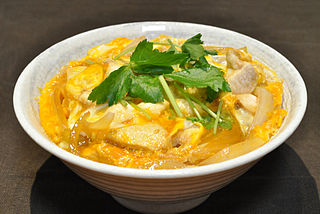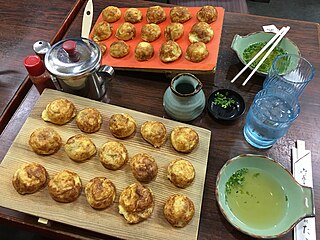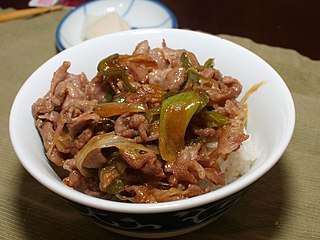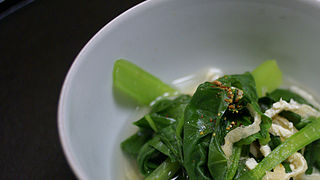 | |
| Alternative names | ひつまぶし |
|---|---|
| Region or state | Tōkai region |
Hitsumabushi is a local dish of Japan, consisting of thinly sliced Kabayaki of Unagi on rice. Hitsumabushi became common in the 1950s, when farm-raised eel became widely available. [1]
 | |
| Alternative names | ひつまぶし |
|---|---|
| Region or state | Tōkai region |
Hitsumabushi is a local dish of Japan, consisting of thinly sliced Kabayaki of Unagi on rice. Hitsumabushi became common in the 1950s, when farm-raised eel became widely available. [1]
The basic style is for the eater to share it in a rice bowl. The first serving is eaten as is; the second serving is topped with negi , wasabi , nori , and/or mitsuba The third serving is poured dashi or green tea with other condiments, to make chazuke . [2] [3]


The origins of this cuisine and when it came to be called Hitsumabushi are not exactly known. The prevailing theory is that it originated in a Ryōtei restaurant in Nagoya, but some say it originated in Tsu City, Mie Prefecture. Others believe that it originated in the Kansai region. [4]
One such restaurant that claims to be the originator is "Atsuta Houraiken" in Atsuta-ku, Nagoya, or ."Iba sho" in Naka-ku, Nagoya. [5]
"Atsuta Houraiken" dates the establishment of Hitsumabushi to the Meiji period. [6] "Atsuta Houraiken" served unagi rice in pottery bowls at that time, but since there were many deliverys and delivery staff often broke empty bowls when they return. Therefore, the bowls were placed in large, break-proof wooden tubs. The restaurant also added a plate for the number of people to share the bowl with. [6] [7] In 1985, "Atsuta Houraiken" applied to register Hitsumabushi as a trademark with the Japan Patent Office, and it was registered in 1987 (see below).
"Ibasyo" states that hitsumabushi was established in the Taishō era. [5] A description of hitsumabushi can be found in the "Ibasho" section of the "Nagoya Mikaku Map" published by Sogensha in 1964. [7] [8]
According to a restaurant founded in 1875 in Tsu, Mie, before eel farming began, they used natural eels, which were of uneven size. The thicker ones were too hard to serve to customers. It would have been a waste to dispose of them, so they were grilled and chopped into small pieces for the employees' meals. The smell of the fish would linger if it was grilled too quickly, so it is assumed that they added condiments and made it into chazuke (rice with green tea). In other words, it was something they had no choice but to eat at that time. The owner of the restaurant heard that it was offered in Nagoya and started offering it as a menu item around 1975, and several restaurants in Tsu also started offering it after receiving inquiries about hitsumabushi. [7]
Some believe it was before the Meiji era. [9]
A book published in Tokyo in 1926, "Spring, Summer, Autumn, Winter Daily Dishes," does not mention the word hitsumabushi, but describes a dish in which grilled eel is cut into 2-3 bu (3–9 mm), placed on freshly cooked rice, and stirred with a liquid of soy sauce, mirin and coarse sugar boiled down. [10]
Some people attribute it to the period of food shortages after World War II. [11] The author of the article, however, later changed the term to "apparently prewar period". [12]
Several hypotheses have been raised as to the origin of the name hitsumabushi.
Hitsumabushi is a registered trademark of Nagoya-based Houraiken Corporation, filed in 1985 and registered in 1987. [15] However, this does not mean that Houraiken is the originator of hitsumabushi. [16] In addition, this was registered as a product, and "offering food and drink" was not subject to registration at the time of application. After this category became eligible for registration, Houraiken applied for a trademark for "offering food and drink," but the Japan Patent Office rejected the application, stating that "most eel restaurants in Nagoya add this to their menus, and it is known throughout the country as a Nagoya specialty." [17]

Nagoya is the largest city in the Chūbu region, the fourth-most populous city proper with a population of 2.3 million in 2020, and the principal city of the Chūkyō metropolitan area, which is the third-most populous metropolitan area in Japan with a population of 10.11 million. Located on the Pacific coast in central Honshu, it is the capital and most populous city of Aichi Prefecture, with the Port of Nagoya being Japan's largest seaport.

Oyakodon (親子丼), literally "parent-and-child donburi", is a donburi, or Japanese rice bowl dish, in which chicken, egg, sliced scallion, and other ingredients are all simmered together in a kind of soup that is made with soy sauce and stock, and then served on top of a large bowl of rice. The name of the dish is a poetic reflection of both chicken and egg being used in the dish.

Akashiyaki (明石焼き) is a small round dumpling from the city of Akashi in Hyōgo Prefecture, Japan. The dumpling is made of an egg-rich batter and octopus dipped into dashi before eating. Modern style akashiyaki first started selling in the Taishō period by a yatai shopper Seitarō Mukai.

Nagoya Castle is a Japanese castle located in Nagoya, Japan.
Rendaku is a phenomenon in Japanese morphophonology that governs the voicing of the initial consonant of a non-initial portion of a compound or prefixed word. In modern Japanese, rendaku is common but at times unpredictable, with certain words unaffected by it.
The classical Japanese language, also called "old writing" and sometimes simply called "Medieval Japanese", is the literary form of the Japanese language that was the standard until the early Shōwa period (1926–1989). It is based on Early Middle Japanese, the language as spoken during the Heian period (794–1185), but exhibits some later influences. Its use started to decline during the late Meiji period (1868–1912) when novelists started writing their works in the spoken form. Eventually, the spoken style came into widespread use, including in major newspapers, but many official documents were still written in the old style. After the end of World War II, most documents switched to the spoken style, although the classical style continues to be used in traditional genres, such as haiku and waka. Old laws are also left in the classical style unless fully revised.

Nagoya University, abbreviated to Meidai (名大) or NU, is a Japanese national research university located in Chikusa-ku, Nagoya.

JOLX-DTV, branded as Mētele is the Chūbu region flagship station of the All-Nippon News Network, owned by the Nagoya Broadcasting Network Co., Ltd., with its headquarters in Nagoya. It is broadcast in Aichi Prefecture, Gifu Prefecture, and Mie Prefecture.

Yakiniku, meaning "grilled meat", is a Japanese term that, in its broadest sense, refers to grilled meat cuisine.

Unadon is a dish originating in Japan. It consists of a donburi type large bowl filled with steamed white rice, and topped with fillets of eel (unagi) grilled in a style known as kabayaki, similar to teriyaki. The fillets are glazed with a sweetened soy-based sauce, called tare and caramelized, preferably over charcoal fire. The fillets are not flayed, and the grayish skin side is placed faced down. Sufficient tare sauce is poured over so that some of it seeps through the rice underneath. By convention, pulverized dried berries of sanshō are sprinkled on top as seasoning. It is also very popular outside of Japan, particularly in Taiwan and the United States.

Kabayaki (蒲焼) is a preparation of fish, especially unagi eel, where the fish is split down the back, gutted and boned, butterflied, cut into square fillets, skewered, and dipped in a sweet soy sauce-based marinade before being cooked on a grill or griddle.

The Higashi-Meihan Expressway is a four lane national expressway in the Tōkai region of Japan. It is owned and operated by Central Nippon Expressway Company.

The Ibaraki dialect is a Japanese dialect spoken in Ibaraki Prefecture. It is noted for its distinctive use of the sentence-ending particles べ (be) and っぺ (ppe) and an atypical intonation pattern that rises in neutral statements and falls in questions. It is also noted for its merging of certain vowels, frequent consonant voicing, and a relatively fast rate of speech.

Butadon (豚丼), often literally translated into English as pork bowl, is a Japanese dish consisting of a bowl of rice topped with pork simmered in a mildly sweet sauce. It also often includes a sprinkling of green peas. A popular food in Japan, it is commonly served with takuan. Buta means "pig" or "pork", and don is short for donburi, the Japanese word for "bowl". Butadon originated from the city of Obihiro, Japan.

Manaca, stylized in lowercase as manaca is a rechargeable contactless smart card used in Nagoya, Japan and the surrounding area in Aichi Prefecture. It launched on February 11, 2011, replacing the Tranpass magnetic fare card system. Since 2013, it has been part of Japan's Nationwide Mutual Usage Service, allowing it to be used in all major cities across the country.

Ikameshi is a Japanese dish of rice-filled squid. It is a regional dish from the Oshima area of Hokkaidō.
The Braille pattern dots-5 is a 6-dot braille cell with the middle right dot raised, or an 8-dot braille cell with the upper-middle right dot raised. It is represented by the Unicode code point U+2810, and in Braille ASCII with a quote mark: ".

Kaiseki (懐石) or kaiseki-ryōri is a traditional multi-course Japanese dinner. The term also refers to the collection of skills and techniques that allow the preparation of such meals and is analogous to Western haute cuisine.

Namerō is a type of tataki, a manner of preparing fish or meat finely minced and mixed with some spices and seasonings, not unlike a tartare.

Nagoya cuisine is a Japanese regional cuisine of the city of Nagoya and surrounding region in central Japan. Due to differences in culture, historical contact between other regions, climate, vegetables and other ingredients, Nagoya cuisine has unique features. Although many dishes derived from local tradition, Nagoya cuisine has been inspired by foreign cuisines such as Italian cuisine, Taiwanese cuisine, Indian cuisine, and mainland Chinese cuisine.